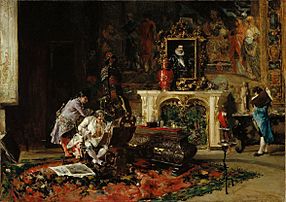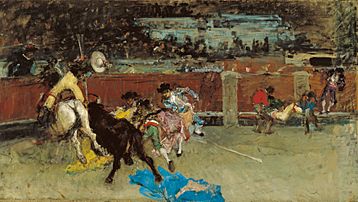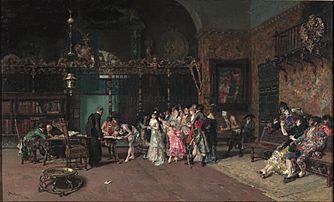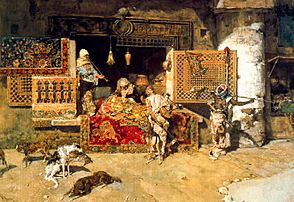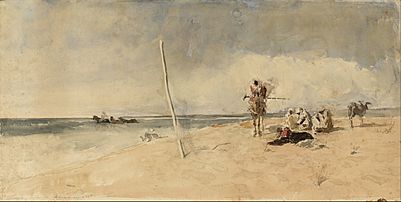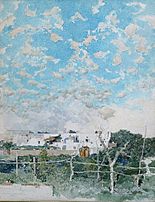Marià Fortuny facts for kids
Quick facts for kids
Marià Fortuny
|
|
|---|---|
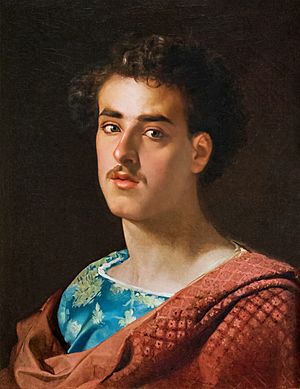
Self portrait by Marià Fortuny (1863–73)
|
|
| Born |
Marià Josep Maria Bernat Fortuny i Marsal
June 11, 1838 |
| Died | November 21, 1874 (aged 36) Rome
|
| Nationality | Spanish |
| Education | Academy of Barcelona (La Llotja school of art); Academia Gigi, Rome |
| Known for | Painting |
| Movement | Romanticism; Orientalist |
| Spouse(s) | Cecelia de Madrazo y Garreta |
Marià Fortuny (born June 11, 1838 – died November 21, 1874) was one of the most important Spanish painters of his time. He was known around the world for his art. Even though he had a short career, he painted many different things. These included scenes inspired by his travels to places like Morocco, historical events, and military battles. His paintings were known for their bright colors and lively brushstrokes.
Contents
About Marià Fortuny's Life
Marià Fortuny was born in Reus, a town near Tarragona in Catalonia, Spain. He lost his parents when he was very young. His grandfather, who was a cabinet-maker, raised him and taught him to make small wax figures. When Marià was nine, a local painter named Domènec Soberano saw his talent at a competition and encouraged him to study art more. At 14, he moved to Barcelona with his grandfather to pursue his dream.
Becoming an Artist
A sculptor named Domènec Talarn helped Marià get a scholarship to study at a famous art school in Barcelona called the Escola de la Llotja. He studied there for four years. In 1857, he won another scholarship that allowed him to study in Rome for two years, starting in 1858. In Rome, he learned drawing and grand painting styles with other artists like Ricardo de Madrazo.
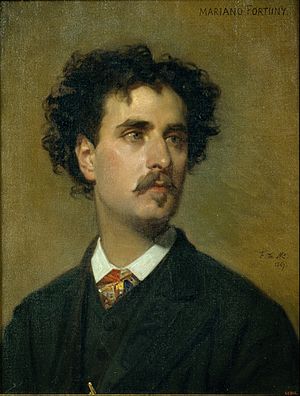
In 1859, the government of Barcelona asked him to paint scenes from the Spanish-Moroccan War. He traveled to Morocco for a few months, making sketches of the landscapes and battles. These sketches later helped him create his huge painting, The Battle of Tetuan.
Life in Granada
In 1870, Fortuny and his family moved to Granada, a beautiful city in Andalusia. They had planned to just visit, but Fortuny loved it so much that he decided to stay and work there. They lived in Granada for about two and a half years. Fortuny set up a studio, a place where he could paint, in a house known as Casa de Buena Vista.
Since the time of famous painters like Diego Velázquez, it was common in Spain to paint large pictures of battles and victories. Based on his experiences in Morocco, Fortuny was asked to paint a huge canvas showing the Spanish army capturing enemy camps. He started working on The Battle of Tetuan, a painting 15 meters long, but he never fully finished it.
Family and Later Years
His travels to Morocco had a big impact on Fortuny. He became very interested in the exotic themes of the Moroccan world, painting people and imagined court scenes. In 1868, he visited Paris and soon after married Cecilia de Madrazo. Cecilia was the daughter of Federico de Madrazo, who later became the curator of the Prado Museum in Madrid. She was also the sister of Fortuny's friend, Ricardo de Madrazo, who had traveled with Fortuny before.
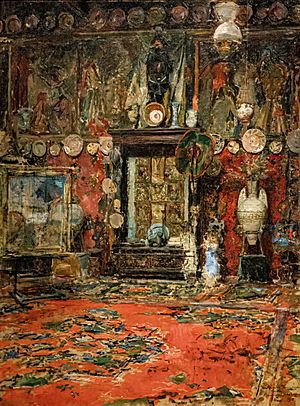
Marià and Cecilia had a son named Mariano Fortuny y Madrazo, who grew up to be a famous fashion and tapestry designer. After another visit to Paris in 1870 and his time in Granada, Fortuny returned to Rome. He sadly died suddenly on November 21, 1874, from malaria. He had caught the illness while painting outdoors in Naples and Portici during the summer of that year.
After Fortuny's death, his brother-in-law, Ricardo de Madrazo, took care of his studio. He made a list of all his artworks and arranged for them to be sold at an auction.
Marià Fortuny's Legacy
Fortuny's paintings are known for their bright colors and lively brushstrokes. His style sometimes reminds people of the soft look of Rococo painting, but it also showed early signs of the Impressionist style that would become popular later.
Gallery
Paintings
-
The Slaying of the Abencerrages, c. 1870
Works on Paper
See also
 In Spanish: Mariano Fortuny para niños
In Spanish: Mariano Fortuny para niños
- List of Orientalist artists
- Orientalism
- Palazzo Fortuny in Venice, Italy
- List of Marià Fortuny's Paintings (in Catalan)


